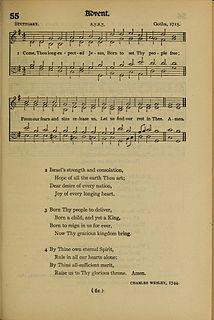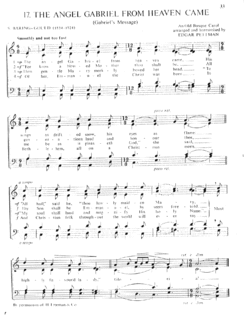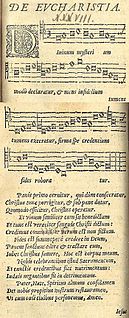 W
W"Adam lay ybounden", originally titled Adam lay i-bowndyn, is a 15th-century macaronic English Christian text of unknown authorship. It relates the Biblical events of Genesis, Chapter 3 on the Fall of Man.
 W
W"Come, Thou Long Expected Jesus" is a 1744 Advent and Christmas carol common in Protestant hymnals. The text was written by Charles Wesley. It is performed to one of several tunes, including "Stuttgart" and "Hyfrydol". It is hymn number 66 in the Episcopal Church hymnal ; hymn number 196 in the United Methodist Hymnal ; hymns 1 and 2 in the 1990 Presbyterian Hymnal; and hymn 254 in Evangelical Lutheran Worship, among others. The hymn is considered an enduring classic in Christian hymnody.
 W
WConditor alme siderum is a seventh-century Latin hymn used during the Christian liturgical season of Advent. It was formerly ascribed to Saint Ambrose, but there is no contemporaneous evidence to support the attribution. The hymn has been mainly used in the Divine Office at Vespers. An English translation by J.M. Neale is the well-known Advent hymn Creator of the Stars of Night.
 W
W"Es ist ein Ros entsprungen", is a Christmas carol and Marian Hymn of German origin. It is most commonly translated in English as "Lo, how a rose e'er blooming", and is sometimes known as "A Spotless Rose" or "Behold a Rose of Judah". The rose in the text is a symbolic reference to the Virgin Mary, and the hymn makes reference to the Old Testament prophecies of Isaiah which in Christian interpretation foretell the Incarnation of Christ, and to the Tree of Jesse, a traditional symbol of the lineage of Jesus. Because of its prophetic theme, the song is popular during the Christian season of Advent.
 W
W"Es kommt ein Schiff, geladen", is an Advent season chorale and Marian Hymn. It is one of the oldest religious songs of German origin.
 W
W"Gabriel's Message" or "The angel Gabriel from heaven came" is a Basque Christmas folk carol about the Annunciation to the Virgin Mary by the archangel Gabriel that she would become the mother of Jesus Christ the Son of God.
 W
W"The Holly and the Ivy" is a traditional British folk Christmas carol, listed as number 514 in the Roud Folk Song Index. The song can be traced only as far as the early nineteenth century, but the lyrics reflect an association between holly and Christmas dating at least as far as medieval times. The lyrics and melody varied significantly in traditional communities, but the song has since become standardised. The version which is now popular was collected in 1909 by the English folk song collector Cecil Sharp in the market town of Chipping Campden in Gloucestershire, England, from a woman named Mary Clayton.
 W
WJesus Christ the Apple Tree is a poem, possibly intended for use as a carol, written in the 18th century. It has been set to music by a number of composers, including Jeremiah Ingalls (1764–1838), Elizabeth Poston (1905–1987), John Rutter, and Stanford Scriven (b.1988)
 W
W"Lo! He comes with clouds descending" is a hymn with a text by John Cennick (1718–1755) and Charles Wesley (1707–1788). Most commonly sung at Advent, the hymn derives its theological content from the Book of Revelation relating imagery of the Day of Judgment. Considered one of the "Great Four Anglican Hymns" in the 19th century, it is most commonly sung to the tune Helmsley, first published in 1763.
 W
W"Long Ago, Prophets Knew", also called "Long Ago, Prophets Knew, Christ would come born a Jew", is an English Christian Advent carol written by Reverend Fred Pratt Green in 1970.
 W
W"Macht hoch die Tür" is a German popular Advent hymn, written in Ducal Prussia in the 17th century. The incipit is the first line, "Macht hoch die Tür, die Tor macht weit. The lyrics were written by Georg Weissel in 1623, for the inauguration of the Altroßgärter Kirche in Königsberg. The melody that is now associated with the text appeared first in 1704 in the hymnal by Johann Anastasius Freylinghausen.
 W
W"Macht weit die Pforten in der Welt" is a Christian hymn with German text by Albert Knapp written for the Basel Mission and first published in 1829. It appeared in 19th-century German hymnals, to be sung with the melody of "Wie schön leuchtet der Morgenstern". It appeared in the 1938 hymnal Kirchenlied with a new melody by Adolf Lohmann. The song is part of the 2013 German Catholic hymnal Gotteslob.
 W
W"Maria durch ein Dornwald ging" is a German Advent song. By origin it was a pilgrimage song that initially was spread verbally in the 19th century, starting in the catholic Eichsfeld.
 W
W"Nun komm, der Heiden Heiland" is a Lutheran chorale of 1524 with words written by Martin Luther, based on "Veni redemptor gentium" by Ambrose, and a melody, Zahn 1174, based on its plainchant. It was printed in the Erfurt Enchiridion of 1524.
 W
WThe O Antiphons, also known as The great Os, are Magnificat antiphons used at Vespers of the last seven days of Advent in Western Christian traditions. They are also used as the Alleluia verses on the same days in the post-1970 form of the Catholic Mass, although the Lectionary moves O Emmanuel to the 21st, uses Rex Gentium on both the 22nd and 23rd, and places O Oriens on the morning of the 24th, with authorization for the traditional ordering from the 17th through the 23rd.
 W
WThe O Antiphons, also known as The great Os, are Magnificat antiphons used at Vespers of the last seven days of Advent in Western Christian traditions. They are also used as the Alleluia verses on the same days in the post-1970 form of the Catholic Mass, although the Lectionary moves O Emmanuel to the 21st, uses Rex Gentium on both the 22nd and 23rd, and places O Oriens on the morning of the 24th, with authorization for the traditional ordering from the 17th through the 23rd.
 W
W"O come, O come, Emmanuel" is a Christian hymn for Advent and Christmas. The text was originally written in Latin. It is a metrical paraphrase of the O Antiphons, a series of plainchant antiphons attached to the Magnificat at Vespers over the final days before Christmas. The hymn has its origins over 1,200 years ago in monastic life in the 8th or 9th century. Seven days before Christmas Eve monasteries would sing the “O antiphons” in anticipation of Christmas Eve when the eighth antiphon, “O Virgo virginum” would be sung before and after Mary’s canticle, the Magnificat. The Latin metrical form of the hymn was composed as early as the 12th century.
 W
W"O Heiland, reiß die Himmel auf" is a Christian Advent song. The text was first printed in 1622, attributed to Friedrich Spee; the melody was first printed in 1666.
 W
WThe O Antiphons, also known as The great Os, are Magnificat antiphons used at Vespers of the last seven days of Advent in Western Christian traditions. They are also used as the Alleluia verses on the same days in the post-1970 form of the Catholic Mass, although the Lectionary moves O Emmanuel to the 21st, uses Rex Gentium on both the 22nd and 23rd, and places O Oriens on the morning of the 24th, with authorization for the traditional ordering from the 17th through the 23rd.
 W
W"Of the Father's heart begotten" alternatively known as "Of the Father's love begotten" is a doctrinal hymn based on the Latin poem "Corde natus" by the Roman poet Aurelius Prudentius, from his Liber Cathemerinon beginning "Da puer plectrum" which includes the Latin stanzas listed below.
 W
WRorate caeli or Rorate coeli are the opening words of Isaiah 45:8 in the Vulgate. The text appears at several points in the Christian liturgy during Advent.
 W
W"Tochter Zion, freue dich" is a Christian Advent song in German. The text was written by Friedrich Heinrich Ranke, based on music derived from two of Handel's oratorios. The song was published in 1826, assigned to the Entry into Jerusalem. The hymn is part of the German Protestant hymnal Evangelisches Gesangbuch as EG 13 and the 2013 Catholic hymnal Gotteslob as GL 228, both four-part settings in the Advent section.
 W
W"Wachet auf, ruft uns die Stimme" is a Lutheran hymn written in German by Philipp Nicolai, first published in 1599 together with "Wie schön leuchtet der Morgenstern". It appears in German hymnals and in several English hymnals in translations such as "Wake, Awake, for Night Is Flying", "Wake, O wake! with tidings thrilling", and "Up! Awake! From Highest Steeple". Johann Sebastian Bach based a chorale cantata on the hymn, Wachet auf, ruft uns die Stimme, BWV 140, one of its many musical settings.